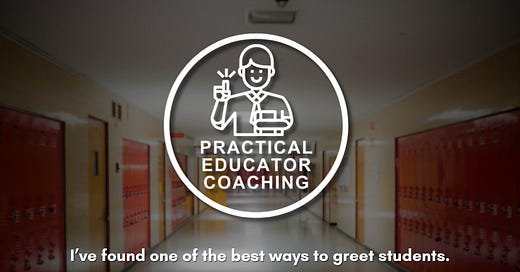A Better Way to Greet Students Outside the Classroom
How one phrase can strengthen student belonging
Hey, how’s it going? I’m Erik Johnson—a veteran social studies teacher, university professor, and educator coach. In this newsletter, I share practical teaching tips, deep dives into education topics, and the occasional piece on my personal interests. If it’s your first time here, take a look at my coaching homepage, and don’t forget to subscribe!
A Free Teaching Tip
Genuinely, one of the most important things a teacher can do is be thoughtful about their use of words. In my experience, this wasn’t talked about in teacher school, and it’s certainly not been discussed in any of the many PDs I’ve attended. Yet teaching is a job centered on communication. All we do is communicate. And there’s an art to it that’s absolutely crucial for success in all aspects of the classroom.
For example, there is a huge difference between these two ways to ask for class participation:
Does anyone want to share their bellringer answer?
Before we move on, I’d love to hear three students share their response to the bellringer question.
The first version presents the discussion as optional. The students can simply think to themselves, “Nope!”
The second version expresses the value of hearing responses and also establishes clear, manageable boundaries for the discussion. For students, it makes participation feel appreciated and contained. There’s a beginning, middle, and end to this slice of the lesson.
When I observe new or struggling teachers, I often notice issues with word choice that result in their message being muddled or their questions sounding rhetorical. When students are confused and the teacher sounds like they’re speaking to the void, the result is far from an engaging or productive class period. This problem tends to compound, especially as it erodes the sense that the teacher is in control of the class.
Along these lines, I’ve recently stumbled upon another small but meaningful semantic shift. I think I’ve found one of the best ways to greet students. Stick with me and let me know what you think.
I greet and interact with all of my students as I see them in the halls, often with my old standby, “Hey, how’s it going?” I say this to everyone. My wife makes fun of me for it. It doesn’t typically lead to a meaningful interaction. The recipient of the “how’s it going?” can really only respond in one socially acceptable way: “Good!”
A pleasant, but tenuous connection made.
After a recent visit home, I picked up a phrase my father always says when I visit. Without thinking, I started using it when I ran into students (especially former students) in the halls. It’s a simple, commonly used expression, but the resulting interaction felt far more meaningful. As I passed a former student in the hallway the other day, I said, “Good to see you!”
Their response: “Good to see you too!”
We continued on our way, but the moment felt really special. As a teacher—especially in high school—it’s crucial to communicate care for your students. In conversations, students often tell me they feel like their teachers don’t like them. So, with this simple greeting, I’m not only expressing care for my students—they also get a chance to express that care back. That kind of connection matters, particularly in the way it fosters a sense of belonging for students, which has an array of positive outcomes.
I’ve repeated this exchange multiple times since, and it’s felt meaningful every time. After all, words shape relationships. And in a job built entirely on relationships, they deserve our attention. “Good to see you” might seem small, but it’s a reminder that even small shifts in language—when intentional—can build trust, connection, and a sense of belonging.





Great observation. I’ve been trying to make this phrase my go-to, for all the reasons you mention. In related news, I recently learned that, for many people in the US South, “I appreciate you” is a sincere a meaningful phrase—not just a throwaway line. So now I’m trying to use that, as well.
Well said! I completely agree that teacher prep programs should provide teachers with public speaking. Even lessons from improv, like "yes, and" make a difference in classroom interactions. I always heard the advice, if you won't accept "no" as an answer, don't make it an option.
I also like how you said, "words shape relationships." That's a chewy idea, got me thinking about the difference in what is said and what is communicated.